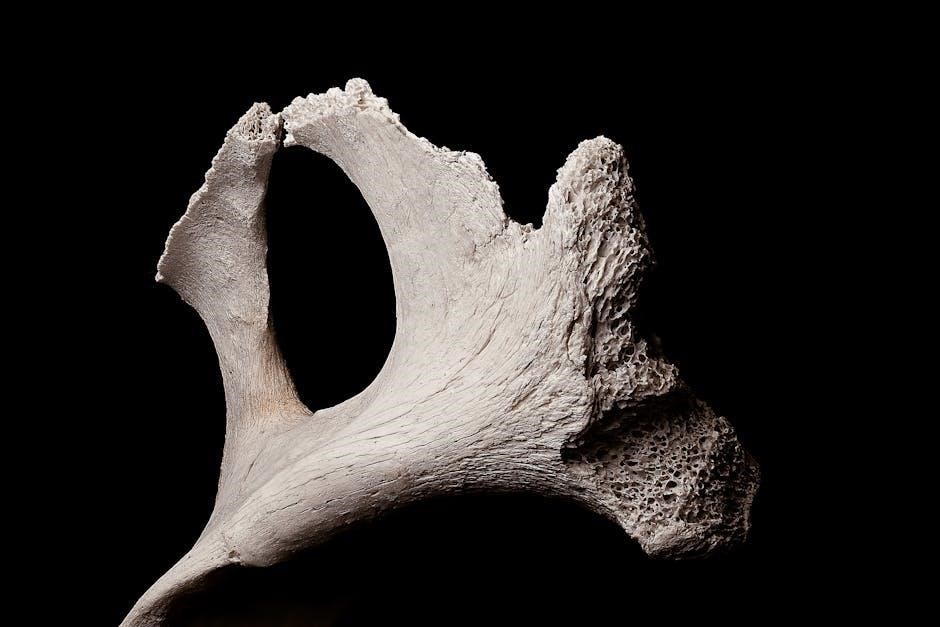This worksheet explores key evidence for evolution, including fossils, comparative anatomy, embryology, and molecular biology. It provides structured activities to analyze evolutionary processes, fostering critical thinking and understanding of evolutionary biology concepts.
1.1 Overview of the Worksheet
This worksheet provides a structured approach to understanding evolutionary evidence, covering fossils, comparative anatomy, embryology, and molecular biology. It includes key concepts like transitional fossils and vestigial structures, offering a comprehensive guide for students to analyze and interpret evolutionary processes. The resource is designed to promote critical thinking and deeper understanding of evolutionary biology. By exploring these areas, students can evaluate the strengths and limitations of each type of evidence, fostering a well-rounded perspective on evolution.
1.2 Importance of Understanding Evolutionary Evidence
Understanding evolutionary evidence is crucial for grasping the fundamental principles of biology and the natural world. It provides insights into the diversity of life, common ancestry, and adaptation mechanisms. By studying fossils, comparative anatomy, embryology, and molecular biology, students develop critical thinking skills and a scientific perspective. This knowledge also underpins advancements in medicine, ecology, and conservation, emphasizing the relevance of evolution in real-world applications and its role in shaping life on Earth.
Fossil Record as Evidence for Evolution
The fossil record reveals life’s progression over time, with transitional fossils like early whales and feathered dinosaurs showcasing evolutionary links. Fossils demonstrate increasing complexity, supporting evolution.
2.1 Transitional Fossils and Their Significance
Transitional fossils bridge evolutionary gaps, showcasing characteristics of ancestral and descendant species. Examples include early whales with land-adapted limbs and feathered dinosaurs linking to birds. These fossils provide direct evidence of evolutionary change, revealing how species adapted over time. They demonstrate gradual modifications, such as the development of wings in pterosaurs or the transition from fish to amphibians. Transitional fossils are crucial as they validate evolutionary theories, offering tangible evidence of species transformation and adaptation across millions of years.
2.2 The Progression of Complexity in Fossils
The fossil record reveals a gradual increase in the complexity of life forms over time. Early fossils, such as single-celled organisms, are simpler, while later fossils show more intricate structures. This progression supports evolutionary theory, as natural selection favors traits that enhance survival and reproduction. The trend toward complexity is evident in the development of multicellular organisms, specialized organs, and advanced nervous systems. This pattern aligns with the idea of gradual evolution, where species adapt and diversify over millions of years.
2.3 Vestigial Structures in Fossils
Vestigial structures in fossils provide evidence of evolutionary history. These are features that have lost their original function but are still present due to their persistence from ancestral species. For example, the human appendix is a vestigial organ, and fossil records show similar structures in earlier species. The presence of vestigial traits supports evolution by demonstrating how traits can be reduced or modified over time, as natural selection no longer favors their original purpose. This aligns with the concept of descent with modification.
2.4 Example: The Evolution of the Horse
The evolution of the horse is a well-documented example of evolutionary change. Fossil records show a transition from small, multi-toed forest dwellers like Eohippus to modern single-hoofed horses. Over millions of years, adaptations such as tooth structure changes and limb modifications reflect shifts in diet and environment. This gradual progression illustrates how species adapt to their ecosystems, providing clear evidence of evolutionary processes. The horse’s evolutionary history is a key example used in studying fossil-based evidence for evolution.
Comparative Anatomy
Comparative anatomy studies the structural similarities and differences among organisms, revealing homologous features. These shared traits indicate evolutionary relationships, supporting the theory of common ancestry.
3.1 Homologous Structures Across Species

Homologous structures are body parts that differ in form but are similar in embryonic origin, indicating a shared evolutionary ancestry. For example, forelimbs in vertebrates—such as human arms, bird wings, and whale flippers—share similar bone structures despite differing functions. These similarities suggest adaptation from a common ancestral limb structure. Homologous features provide strong evidence for evolution, as they reveal how species have diverged over time while retaining ancestral traits.
3.2 Vestigial Traits and Their Evolutionary Implications
Vestigial traits are features that have lost their original function through evolution but are still present in a reduced form. Examples include the human appendix, wisdom teeth, and male nipples. These traits indicate evolutionary relationships, as they are remnants of structures that were functional in ancestors. Vestigial traits provide evidence of descent with modification, supporting the theory of evolution by showing how species adapt and change over time while retaining ancestral characteristics.
3.3 Analogous Structures and Divergent Evolution
Analogous structures are features that perform similar functions in different species but are not derived from a common ancestor. They arise due to convergent evolution, where unrelated species adapt to similar environmental challenges. For example, the wings of birds and insects serve the same purpose but evolved independently. This divergence highlights how different evolutionary paths can lead to similar solutions, providing evidence of adaptation to specific ecological niches rather than a shared ancestry.
3;4 Example: Forelimbs of Vertebrates
The forelimbs of vertebrates, such as human arms, bird wings, and whale flippers, illustrate homologous structures. Despite their differing forms and functions, these limbs share a common bone structure, reflecting a shared ancestry. This similarity highlights how evolutionary adaptations modify ancestral traits to suit specific environments and lifestyles. The forelimbs exemplify how natural selection drives functional changes while retaining underlying structural similarities, providing strong evidence for evolutionary relationships among diverse species.
Embryology as Evidence for Evolution
Embryology reveals shared ancestral traits, as different species’ embryos show similar features, such as gill slits or tails, which often disappear before birth.
4.1 Early Similarities in Embryos of Different Species
Early embryos of different species often exhibit striking similarities, such as gill slits, tail structures, and limb buds, even if these features are not present in the adult form. These shared traits suggest a common ancestry, as embryos of related species develop from similar genetic blueprints. For example, fish, birds, and mammals all have gill slits during early development, despite their adult forms differing significantly. These embryonic similarities provide strong evidence for evolutionary relationships, as they reflect shared ancestral characteristics.
4.2 Vestigial Features in Embryonic Development
Vestigial features in embryonic development are structures that appear in early stages but disappear before birth. These remnants, like gill slits in humans or tail structures in embryos, indicate evolutionary connections to ancestral species. For example, human embryos temporarily develop a caudal structure that regresses, reflecting our shared ancestry with tailed vertebrates. These vestigial traits provide evidence of evolutionary history, as they are remnants of features once functional in distant relatives but no longer needed in modern species.
4.3 Example: Gill Slits and Tail Structures
In human embryos, temporary gill slits appear early in development, later disappearing. These structures are evolutionary remnants of our fish-like ancestors, where gills were essential for respiration. Similarly, embryos of many mammals develop a tail, which regresses before birth. These vestigial features highlight shared ancestry with other vertebrates, providing direct evidence of evolutionary relationships. Such traits are non-functional in modern species but reflect ancestral adaptations preserved through generations.

4.4 Strengths and Weaknesses of Embryology as Evidence
Embryology provides strong evidence for evolution by revealing shared developmental patterns across species, indicating common ancestry. A key strength is the clarity of early embryonic similarities, which are difficult to explain without evolutionary relationships. However, embryology’s weaknesses include the potential for convergent development, where unrelated species may exhibit similar traits. Additionally, embryonic stages can be influenced by environmental factors, complicating interpretations. While embryology supports evolutionary theory, it is most effective when combined with other evidence, such as fossils and molecular biology.

Molecular Biology and Evolution
Molecular biology provides strong evidence for evolution through DNA and protein comparisons, revealing genetic similarities across species and supporting common ancestry. Molecular clocks track evolutionary timelines.
5.1 DNA and Protein Comparisons
DNA and protein comparisons are critical in understanding evolutionary relationships. Similarities in genetic material across species indicate shared ancestry, while differences suggest evolutionary divergence over time. For instance, comparisons of cytochrome c proteins reveal strong similarities between closely related species and greater differences among distantly related ones. These molecular data support the theory of evolution by demonstrating how mutations and natural selection shape genetic variation. Such analyses provide a robust framework for mapping evolutionary timelines and relationships.
5;2 Cytochrome c and Evolutionary Relationships
Cytochrome c, a protein found in many organisms, is a key molecule in studying evolutionary relationships. The amino acid sequences of this protein vary among species, with closely related species showing fewer differences. For example, humans and chimpanzees have nearly identical Cytochrome c, while humans and horses exhibit greater differences. These variations provide evidence for evolution, as they reflect the degree of relatedness and shared ancestry among species. Such molecular data strongly support Darwin’s theory of common descent and evolutionary divergence over time.
5.3 Molecular Clocks and Evolutionary Timelines
Molecular clocks estimate evolutionary timelines by comparing DNA or protein sequences. Based on mutation rates, they calculate divergence times between species. For instance, comparing cytochrome c sequences reveals when different species split from common ancestors. While accurate in many cases, factors like varying mutation rates and natural selection can affect reliability. Despite these challenges, molecular clocks provide a powerful tool for reconstructing evolutionary relationships and understanding the timing of evolutionary events. They complement fossil records and other evidence to build comprehensive evolutionary histories.
5.4 Example: Molecular Evidence for Human Evolution
Molecular evidence strongly supports human evolution, with DNA comparisons showing 98-99% similarity between humans and chimpanzees. Mitochondrial DNA traces human origins to Africa, while Y-chromosome studies reveal migration patterns. Protein comparisons, such as hemoglobin, align humans with primates. Fossil DNA, like Neanderthal sequences, confirms interbreeding. These molecular markers provide a clear evolutionary timeline, linking humans to a common ancestor with other species and illustrating the genetic basis of human evolution through shared ancestry and gradual divergence.

Mechanisms of Evolution
Evolution occurs through natural selection, genetic drift, mutation, and gene flow. These mechanisms drive changes in populations, shaping biodiversity and adaptation over generations.
6.1 Natural Selection and Its Role in Evolution
Natural selection is a fundamental mechanism driving evolution, where individuals with advantageous traits are more likely to survive and reproduce. Environmental pressures favor specific traits, leading to their increased prevalence in populations. Over generations, this process shapes biodiversity and adaptation. For example, the peppered moth’s color shift due to industrial pollution illustrates how natural selection acts on existing variation, ensuring species’ survival in changing environments. It is a key evidence supporting evolutionary biology.
6.2 Genetic Drift and Its Impact on Populations

Genetic drift is a random change in allele frequencies within populations, influencing evolution. It can lead to loss of genetic diversity, as certain alleles may disappear by chance. Small populations are particularly vulnerable, with events like bottlenecks reducing variation. The founder effect illustrates drift, where new populations arise from few individuals, altering allele frequencies. While not driven by selection, genetic drift shapes population genetics and contributes to evolutionary change, often unpredictably.
6.3 Mutation and Gene Flow as Evolutionary Forces
Mutation introduces new alleles into populations, providing raw material for evolution. It can result in beneficial, harmful, or neutral traits. Gene flow, the transfer of genetic material between populations, increases genetic diversity and reduces differentiation. Both processes counteract genetic drift by introducing variation. Mutations create new traits, while gene flow spreads them, fostering adaptation and evolutionary change. Together, they maintain population resilience and drive evolutionary innovation, shaping species over time.

Strengths and Weaknesses of Evolutionary Evidence
Evolutionary evidence offers comprehensive insights through fossils, genetics, and anatomy, yet limitations like incomplete records and interpretative debates exist, requiring interdisciplinary approaches for a balanced understanding.
7.1 Fossil Record Strengths and Limitations
The fossil record provides direct evidence of past life forms, showcasing evolutionary changes over time. It includes transitional fossils, such as Tiktaalik, linking species like fish and amphibians. Strengths lie in its ability to demonstrate gradual adaptations and species diversification. However, limitations include incomplete preservation, as soft tissues rarely fossilize, and gaps in the record due to erosion or lack of fossilization conditions. Additionally, interpreting fossil behaviors and ecological roles can be challenging, making the fossil record both valuable and imperfect for understanding evolution.
7.2 Comparative Anatomy Strengths and Limitations
Comparative anatomy highlights evolutionary relationships through homologous structures, such as forelimbs in vertebrates, indicating common ancestry. This approach strengthens evolutionary theory by revealing shared developmental patterns. However, limitations arise from convergent evolution, where unrelated species develop similar traits. Additionally, anatomical similarities alone cannot determine evolutionary timelines or mechanisms, requiring complementation with fossil or molecular data. Thus, comparative anatomy is a powerful yet incomplete tool for understanding evolutionary connections and history.
7.3 Embryology Strengths and Limitations

Embryology provides strong evidence for evolution by revealing early developmental similarities across species, such as gill slits and tail structures in vertebrates. These embryonic features suggest shared ancestry and evolutionary relationships. However, embryology has limitations, as some traits are transient and hard to study. Additionally, environmental factors can influence embryonic development, complicating interpretations. While embryology is a powerful tool for understanding evolution, it requires integration with other evidence, like fossils or molecular data, for a comprehensive understanding.

7.4 Molecular Biology Strengths and Limitations
Molecular biology provides robust evidence for evolution through DNA and protein comparisons, revealing genetic similarities and differences. It identifies evolutionary relationships, such as shared ancestry in cytochrome c studies. Strengths include precision and quantifiable data. However, limitations arise from complexity, requiring specialized expertise. Molecular clocks assume constant mutation rates, which may vary. Additionally, genetic drift and random mutations can complicate interpretations. Despite these challenges, molecular biology remains a powerful, objective tool for tracing evolutionary pathways and confirming evolutionary theories.

Educational Resources for Teaching Evolution
Engage students with diverse tools like worksheets, interactive simulations, and textbooks. These resources simplify complex concepts, fostering a deeper understanding of evolutionary biology and its evidence.
8.1 Worksheets and Activity Guides
Worksheets and activity guides are essential tools for teaching evolution. They provide structured exercises, such as crossword puzzles, fill-in-the-blank questions, and case studies, to engage students. These resources often include diagrams, like fossil records or comparative anatomy charts, to visualize evolutionary concepts. Activity guides may offer hands-on tasks, such as simulating natural selection or analyzing DNA sequences. Many worksheets are available online, including PDF formats, making them accessible for classroom use. They cater to varying learning styles, ensuring comprehensive understanding of evolutionary evidence and processes.
8.2 Interactive Tools and Simulations
Interactive tools and simulations are dynamic resources for teaching evolution. They include online platforms like PhET Interactive Simulations, which offer virtual labs and games to explore concepts such as natural selection, genetic drift, and speciation. These tools allow students to manipulate variables, observe outcomes, and engage deeply with evolutionary processes. Simulations often provide real-time visualizations of population dynamics and adaptation, making abstract concepts more tangible. They are particularly effective for visual learners and enhance critical thinking and problem-solving skills in an engaging manner.
8.3 Recommended Textbooks and Online Materials
Recommended textbooks include Biology by Campbell and Reece, and The Selfish Gene by Richard Dawkins, which provide comprehensive insights into evolutionary biology. Online materials such as Khan Academy’s evolution series and Coursera’s evolutionary biology courses offer structured learning. Additionally, educational PDF guides like the Evidence for Evolution Worksheet are invaluable for hands-on activities. These resources blend theoretical knowledge with practical exercises, ensuring a well-rounded understanding of evolutionary concepts for students and educators alike.
The study of evolutionary evidence is crucial for understanding life’s diversity. Fossils, anatomy, embryology, and molecular biology provide a comprehensive framework. Education fosters critical thinking and appreciation for scientific inquiry.
9.1 Summary of Key Evidence for Evolution
The evidence for evolution is comprehensive, encompassing fossils, comparative anatomy, embryology, and molecular biology. Fossils reveal transitional forms and progressive complexity. Homologous structures and vestigial traits highlight shared ancestry. Embryonic similarities and molecular sequences confirm evolutionary relationships. These interconnected lines of evidence collectively support the theory of evolution, providing a robust framework for understanding life’s diversity and interconnectedness across time.
9.2 The Importance of Evolutionary Biology in Education
Teaching evolutionary biology fosters a deep understanding of life’s diversity and interconnectedness. It equips students with critical thinking skills, enabling them to analyze scientific evidence and comprehend the mechanisms driving biodiversity. Evolutionary concepts are foundational to fields like medicine, ecology, and agriculture. By integrating evolutionary biology into education, we cultivate scientifically literate individuals capable of addressing global challenges and appreciating the complexity of life on Earth.
